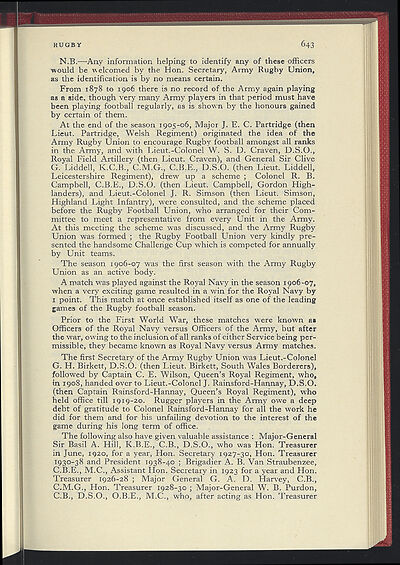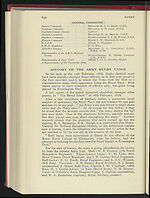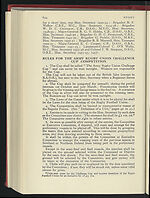1959-60
(713)
Download files
Complete book:
Individual page:
Thumbnail gallery: Grid view | List view

RUGBY
6
43
N.B.—Any information helping to identify any of these officers
would be «elcomed by the Hon. Secretary, Army Rugby Union,
as the identification is by no means certain.
From 1878 to 1906 there is no record of the Army again playing
as a aide, though very many Army players in that period must have
been playing football regularly, as is shown by the honours gained
by certain of them.
At the end of the season 1905-06, Major J. E. C. Partridge (then
I.ieut. Partridge, Welsh Regiment) originated the idea of the
Army Rugby Union to encourage Rugby football amongst all ranks
in the Army, and with Lieut.-Colonel W. S. D. Craven, D.S.O.,
Royal Field Artillery (then Lieut. Craven), and General Sir Clive
G. Liddell, K.C.B., C.M.G., C.B.E., D.S.O. (then Lieut. Liddell,
Leicestershire Regiment), drew up a scheme ; Colonel R. B.
Campbell, C.B.E., D.S.O. (then Lieut. Campbell, Gordon High-
landers), and Lieut.-Colonel J. R. Simson (then Lieut. Simson,
Highland Light Infantry), were consulted, and the scheme placed
before the Rugby Football Union, who arranged for their Com-
mittee to meet a representative from every Unit in the Army.
At this meeting the scheme was discussed, and the Army Rugby
Union was formed ; the Rugby Football Union very kindly pre-
sented the handsome Challenge Cup which is competed for annually
by Unit teams.
The season igo6-07 was the first season with the Army Rugby
Union as an active body.
A match was played against the Royal Navy in the season igo6
-07,
when a very exciting game resulted in a win for the Royal Navy by
i point. This match at once established itself as one of the leading
games of the Rugby football season.
Prior to the First World War, these matches were known as
Officers of the Royal Navy versus Officers of the Army, but after
the war, owing to the inclusion of all ranks of either Service being per-
missible, they became known as Royal Navy versus Army matches.
The first Secretary of the Army Rugby Union was Lieut.-Colonel
G. H. Birkett, D.S.O. (then Lieut. Birkett, South `'Vales Borderers),
followed by Captain C. E. Wilson, Queen's Royal Regiment, who,
in 1908, handed over to Lieut.-Colonel J. Rainsford-Hannay, D.S.O.
(then Captain Rainsford-Hannay, Queen's Royal Regiment), who
held office till 1919
-20.
Rugger players in the Army owe a deep
debt of gratitude to Colonel Rainsford-Hannay for all the work he
did for them and for his unfailing devotion to the interest of the
game during his long term of office. .
The following also have given valuable assistance : Major-General
Sir Basil A. Hill, K.B.E.; C.B., D.S.O., who was Hon. Treasurer
in June,
1920,
for a year, Hon. Secretary 1927
-30,
Hon. Treasurer
1930-38 and President 1938-40 ; Brigadier A. B. Van Straubenzee,
C.B.E., M.C., Assistant Hon. Secretary in 1923 for a year and Hon.
Treasurer 1926-28 ; Major General G. A. D. Harvey, C.B.,
C.M.G., Hon. Treasurer 1928-30 ; Major-General W. B. Purdon,
C.B., D.S.O., O.B.E., M.C., who, after acting as Hon. Treasurer
6
43
N.B.—Any information helping to identify any of these officers
would be «elcomed by the Hon. Secretary, Army Rugby Union,
as the identification is by no means certain.
From 1878 to 1906 there is no record of the Army again playing
as a aide, though very many Army players in that period must have
been playing football regularly, as is shown by the honours gained
by certain of them.
At the end of the season 1905-06, Major J. E. C. Partridge (then
I.ieut. Partridge, Welsh Regiment) originated the idea of the
Army Rugby Union to encourage Rugby football amongst all ranks
in the Army, and with Lieut.-Colonel W. S. D. Craven, D.S.O.,
Royal Field Artillery (then Lieut. Craven), and General Sir Clive
G. Liddell, K.C.B., C.M.G., C.B.E., D.S.O. (then Lieut. Liddell,
Leicestershire Regiment), drew up a scheme ; Colonel R. B.
Campbell, C.B.E., D.S.O. (then Lieut. Campbell, Gordon High-
landers), and Lieut.-Colonel J. R. Simson (then Lieut. Simson,
Highland Light Infantry), were consulted, and the scheme placed
before the Rugby Football Union, who arranged for their Com-
mittee to meet a representative from every Unit in the Army.
At this meeting the scheme was discussed, and the Army Rugby
Union was formed ; the Rugby Football Union very kindly pre-
sented the handsome Challenge Cup which is competed for annually
by Unit teams.
The season igo6-07 was the first season with the Army Rugby
Union as an active body.
A match was played against the Royal Navy in the season igo6
-07,
when a very exciting game resulted in a win for the Royal Navy by
i point. This match at once established itself as one of the leading
games of the Rugby football season.
Prior to the First World War, these matches were known as
Officers of the Royal Navy versus Officers of the Army, but after
the war, owing to the inclusion of all ranks of either Service being per-
missible, they became known as Royal Navy versus Army matches.
The first Secretary of the Army Rugby Union was Lieut.-Colonel
G. H. Birkett, D.S.O. (then Lieut. Birkett, South `'Vales Borderers),
followed by Captain C. E. Wilson, Queen's Royal Regiment, who,
in 1908, handed over to Lieut.-Colonel J. Rainsford-Hannay, D.S.O.
(then Captain Rainsford-Hannay, Queen's Royal Regiment), who
held office till 1919
-20.
Rugger players in the Army owe a deep
debt of gratitude to Colonel Rainsford-Hannay for all the work he
did for them and for his unfailing devotion to the interest of the
game during his long term of office. .
The following also have given valuable assistance : Major-General
Sir Basil A. Hill, K.B.E.; C.B., D.S.O., who was Hon. Treasurer
in June,
1920,
for a year, Hon. Secretary 1927
-30,
Hon. Treasurer
1930-38 and President 1938-40 ; Brigadier A. B. Van Straubenzee,
C.B.E., M.C., Assistant Hon. Secretary in 1923 for a year and Hon.
Treasurer 1926-28 ; Major General G. A. D. Harvey, C.B.,
C.M.G., Hon. Treasurer 1928-30 ; Major-General W. B. Purdon,
C.B., D.S.O., O.B.E., M.C., who, after acting as Hon. Treasurer
Set display mode to:
![]() Universal Viewer |
Universal Viewer | ![]() Mirador |
Large image | Transcription
Mirador |
Large image | Transcription
| Games and sports in the army > 1959-60 > (713) |
|---|
| Permanent URL | https://digital.nls.uk/248872307 |
|---|
| Description | 'Games and Sports in the Army' was an annual publication produced by the British War Office between the 1930s and 1960s. This included the Second World War. It outlines the rules and regulations for games and sports played by members of the armed forces. It features names and photographs of team members, and examples of contemporary advertising. |
|---|---|
| Shelfmark | GWB.52 |

